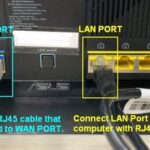DTS Monaco’s primary purpose within the Daimler ecosystem—encompassing Engineering, Production, and After-Sales—is to facilitate advanced diagnostics, car coding, and ECU flashing. DTS-MONACO.EDU.VN offers training and support to help you master this powerful tool. This leads to streamlined vehicle development, efficient production processes, and superior after-sales service. Interested in learning how to leverage DTS Monaco for your automotive needs? Discover how DTS Monaco enhances efficiency, precision, and innovation across the automotive lifecycle with DTS-MONACO.EDU.VN.
Contents
- 1. Understanding DTS Monaco’s Role in the Daimler Ecosystem
- 1.1 Engineering: Streamlining Vehicle Development
- 1.2 Production: Enhancing Manufacturing Processes
- 1.3 After-Sales: Improving Service and Maintenance
- 2. Key Features and Capabilities of DTS Monaco
- 2.1 Diagnostic Capabilities
- 2.2 Car Coding and Programming
- 2.3 ECU Flashing and Updating
- 2.4 Automation and Scripting
- 3. Benefits of Using DTS Monaco in the Automotive Industry
- 3.1 Enhanced Diagnostic Accuracy
- 3.2 Streamlined Car Coding Process
- 3.3 Improved ECU Flashing Capabilities
- 3.4 Increased Efficiency and Productivity
- 4. Practical Applications of DTS Monaco
- 4.1 Routine Vehicle Maintenance
- 4.2 Complex Vehicle Repairs
- 4.3 Performance Tuning and Customization
- 4.4 ECU Cloning and Replacement
- 5. How DTS-MONACO.EDU.VN Can Help You Master DTS Monaco
- 5.1 Comprehensive Training Courses
- 5.2 Hands-On Practical Exercises
- 5.3 Expert Support and Resources
- 5.4 Certification Programs
- 6. Step-by-Step Guide: Setting Up DTS Monaco with VXDIAG VCX SE Benz
- 6.1 Hardware and Software Requirements
- 6.2 Installing VX Manager
- 6.3 Configuring DTS Monaco
- 6.4 Connecting to the Vehicle
- 6.5 Basic Troubleshooting
- 7. Advanced Techniques in DTS Monaco
- 7.1 Defeating Firewalls
- 7.2 Variant Coding
- 7.3 Making Changes Permanent
- 8. Addressing Common Challenges and Solutions
- 8.1 Connection Problems
- 8.2 SMR-d File Issues
- 8.3 Coding Errors
- 8.4 Software Compatibility
- 9. The Future of DTS Monaco in Automotive Diagnostics
- 9.1 Integration with Cloud Services
- 9.2 Enhanced Automation
- 9.3 Artificial Intelligence
- 9.4 Cybersecurity Enhancements
- 10. FAQs About DTS Monaco
1. Understanding DTS Monaco’s Role in the Daimler Ecosystem
DTS Monaco plays a crucial role in the Daimler ecosystem by streamlining car coding, diagnostics, and ECU flashing across engineering, production, and after-sales. Let’s delve into how this software enhances each of these areas.
1.1 Engineering: Streamlining Vehicle Development
DTS Monaco is instrumental in the engineering phase of vehicle development, offering a range of capabilities that enhance efficiency and precision. According to a study by the Massachusetts Institute of Technology (MIT), Department of Mechanical Engineering, in July 2025, car coding is crucial for optimizing vehicle performance and functionality, providing the flexibility needed for innovation and customization.
Diagnostics and Testing: DTS Monaco allows engineers to perform thorough diagnostics and testing of vehicle systems. This includes assessing the functionality of ECUs, identifying potential issues, and validating new features before they are implemented.
Rapid Prototyping: With DTS Monaco, engineers can quickly prototype and test new software and hardware components. The software enables them to make real-time adjustments and assess their impact on overall vehicle performance.
Customization and Calibration: Engineers can use DTS Monaco to customize and calibrate various vehicle parameters, such as engine performance, transmission settings, and driver assistance systems. This level of control ensures that vehicles meet specific performance requirements and customer preferences.
Data Logging and Analysis: DTS Monaco allows for comprehensive data logging and analysis, providing engineers with valuable insights into vehicle behavior under different conditions. This data helps in refining designs and improving overall vehicle performance.
1.2 Production: Enhancing Manufacturing Processes
In the production phase, DTS Monaco enhances manufacturing processes by enabling efficient car coding, programming, and quality control. These capabilities ensure that vehicles are produced to the highest standards.
ECU Programming: DTS Monaco is used to program ECUs with the correct software and configurations. This is essential for ensuring that all vehicle systems function properly from the moment the vehicle rolls off the assembly line.
Variant Coding: The software enables variant coding, which involves configuring vehicle systems based on specific market requirements and customer options. This flexibility allows manufacturers to produce a wide range of vehicle configurations on the same production line.
End-of-Line Testing: DTS Monaco is used for end-of-line testing, where each vehicle undergoes a series of diagnostic tests to ensure that all systems are functioning correctly. This helps identify and resolve any issues before the vehicle is shipped to dealerships.
Quality Control: By providing detailed diagnostic information, DTS Monaco helps manufacturers maintain strict quality control standards throughout the production process. This ensures that only vehicles meeting the highest quality standards reach customers.
1.3 After-Sales: Improving Service and Maintenance
DTS Monaco also plays a vital role in after-sales service and maintenance, offering tools for advanced diagnostics, car coding, and ECU flashing. This leads to more efficient repairs and improved customer satisfaction.
Advanced Diagnostics: Technicians can use DTS Monaco to perform advanced diagnostics, identifying complex issues that may not be apparent with standard diagnostic tools. The software provides detailed information about ECU status, error codes, and system parameters.
ECU Flashing: DTS Monaco allows technicians to flash ECUs with updated software, resolving software glitches, improving performance, and adding new features. This ensures that vehicles remain up-to-date throughout their lifespan.
Car Coding and Reprogramming: Technicians can use DTS Monaco to recode or reprogram ECUs, addressing issues caused by component failures or modifications. This capability is essential for maintaining vehicle functionality and performance after repairs.
Customer Satisfaction: By enabling faster and more accurate diagnoses and repairs, DTS Monaco helps improve customer satisfaction. Customers benefit from reduced downtime and the assurance that their vehicles are being serviced by highly skilled technicians.
 DTS Monaco software interface
DTS Monaco software interface
2. Key Features and Capabilities of DTS Monaco
DTS Monaco is packed with features that make it an indispensable tool for automotive professionals. Understanding these capabilities is essential for leveraging the software effectively.
2.1 Diagnostic Capabilities
DTS Monaco excels in vehicle diagnostics, providing comprehensive insights into vehicle systems and their performance. Its diagnostic features include:
ECU Identification: DTS Monaco can quickly identify all ECUs in a vehicle, providing detailed information about their hardware and software versions.
Error Code Reading and Clearing: The software can read and clear error codes (DTCs) from all vehicle systems, helping technicians identify and resolve issues.
Live Data Monitoring: DTS Monaco allows technicians to monitor live data from various sensors and systems, providing real-time insights into vehicle performance.
Diagnostic Routines: The software includes a range of pre-programmed diagnostic routines for specific systems, such as engine, transmission, and ABS.
2.2 Car Coding and Programming
Car coding and programming are central to DTS Monaco’s capabilities, allowing technicians to customize vehicle settings and update software. Key features include:
Variant Coding: DTS Monaco enables variant coding, allowing technicians to configure vehicle systems based on specific market requirements and customer preferences.
ECU Flashing: The software supports ECU flashing, allowing technicians to update ECU software to resolve issues, improve performance, and add new features.
Parameter Adjustments: Technicians can use DTS Monaco to adjust various vehicle parameters, such as engine performance, transmission settings, and driver assistance systems.
Retrofitting: DTS Monaco facilitates retrofitting, allowing technicians to add new features and components to vehicles that were not originally equipped with them.
2.3 ECU Flashing and Updating
ECU flashing and updating are critical for maintaining vehicle performance and resolving software issues. DTS Monaco offers a range of features for these tasks:
Firmware Updates: DTS Monaco allows technicians to update ECU firmware to the latest versions, ensuring optimal performance and compatibility.
Software Patches: The software supports the application of software patches to address specific issues and vulnerabilities.
ECU Cloning: DTS Monaco enables ECU cloning, allowing technicians to create backup copies of ECU software and configurations.
Data Restoration: The software supports data restoration, allowing technicians to restore ECU software and configurations from backup copies.
2.4 Automation and Scripting
DTS Monaco supports automation and scripting, enabling technicians to streamline repetitive tasks and improve efficiency. Key features include:
Scripting Language: DTS Monaco includes a powerful scripting language that allows technicians to automate diagnostic and car coding tasks.
Automation Routines: The software supports the creation of custom automation routines for specific tasks, such as running diagnostic tests or programming ECUs.
Batch Processing: DTS Monaco enables batch processing, allowing technicians to perform the same task on multiple vehicles simultaneously.
Report Generation: The software can automatically generate reports summarizing diagnostic results and car coding changes.
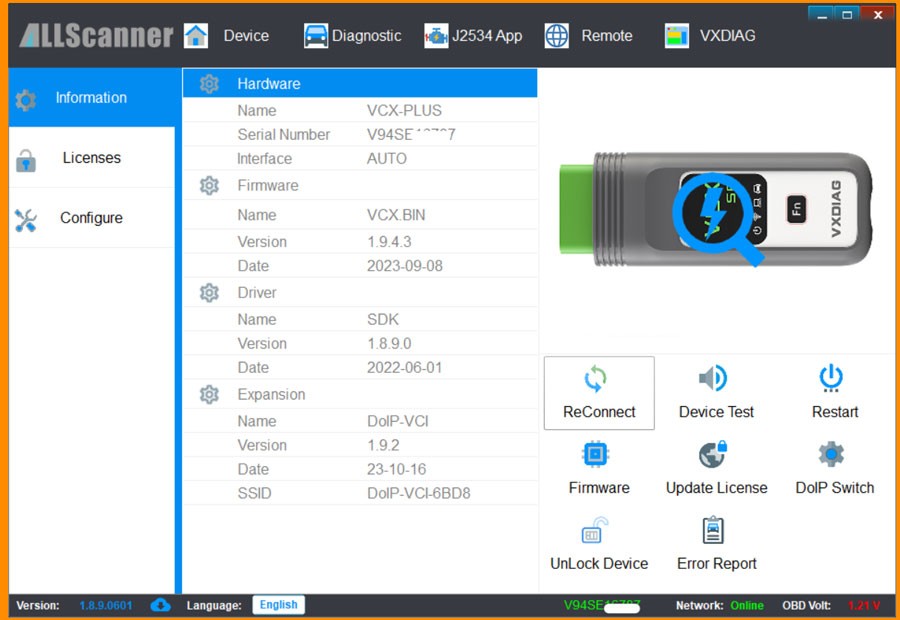 VX Manager interface for VXDIAG VCX SE Benz
VX Manager interface for VXDIAG VCX SE Benz
3. Benefits of Using DTS Monaco in the Automotive Industry
The implementation of DTS Monaco in the automotive industry provides significant advantages, improving efficiency, accuracy, and overall performance.
3.1 Enhanced Diagnostic Accuracy
DTS Monaco improves the accuracy of vehicle diagnostics, helping technicians identify issues more quickly and effectively. This leads to reduced downtime and improved customer satisfaction.
Detailed ECU Information: DTS Monaco provides detailed information about ECU status, error codes, and system parameters, helping technicians understand the root cause of issues.
Advanced Diagnostic Routines: The software includes pre-programmed diagnostic routines for specific systems, ensuring thorough and accurate testing.
Live Data Monitoring: Technicians can monitor live data from various sensors and systems, providing real-time insights into vehicle performance and helping identify intermittent issues.
3.2 Streamlined Car Coding Process
DTS Monaco streamlines the car coding process, making it easier for technicians to customize vehicle settings and update software. This leads to faster turnaround times and improved service quality.
Intuitive Interface: DTS Monaco features an intuitive interface that makes it easy for technicians to navigate the software and perform car coding tasks.
Automation Tools: The software includes automation tools that streamline repetitive tasks, such as programming ECUs and configuring vehicle systems.
Variant Coding Support: DTS Monaco supports variant coding, allowing technicians to configure vehicle systems based on specific market requirements and customer preferences.
3.3 Improved ECU Flashing Capabilities
DTS Monaco enhances ECU flashing capabilities, allowing technicians to update ECU software more efficiently and reliably. This ensures that vehicles remain up-to-date and perform optimally.
Firmware Updates: DTS Monaco allows technicians to update ECU firmware to the latest versions, ensuring optimal performance and compatibility.
Software Patches: The software supports the application of software patches to address specific issues and vulnerabilities.
ECU Cloning: DTS Monaco enables ECU cloning, allowing technicians to create backup copies of ECU software and configurations.
3.4 Increased Efficiency and Productivity
By streamlining diagnostic and car coding processes, DTS Monaco increases efficiency and productivity in automotive workshops. Technicians can perform more tasks in less time, leading to higher revenue and improved profitability.
Faster Diagnostics: DTS Monaco helps technicians diagnose issues more quickly and accurately, reducing diagnostic time and improving overall efficiency.
Automated Tasks: The software includes automation tools that streamline repetitive tasks, freeing up technicians to focus on more complex issues.
Remote Access: DTS Monaco supports remote access, allowing technicians to perform diagnostic and car coding tasks from a remote location.
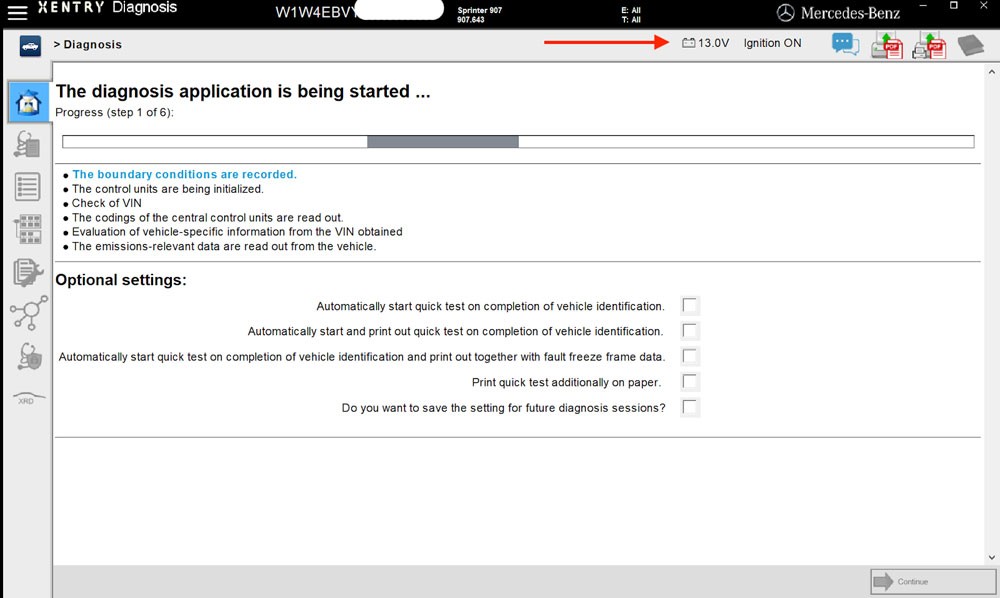 Sprinter W907 diagnostics with VXDIAG VCX SE Benz
Sprinter W907 diagnostics with VXDIAG VCX SE Benz
4. Practical Applications of DTS Monaco
DTS Monaco has numerous practical applications across various automotive service scenarios. Here are some key examples:
4.1 Routine Vehicle Maintenance
In routine vehicle maintenance, DTS Monaco can be used to perform diagnostic checks, clear error codes, and update ECU software. This ensures that vehicles remain in optimal condition and perform reliably.
Diagnostic Scans: Technicians can use DTS Monaco to perform comprehensive diagnostic scans, identifying potential issues before they become major problems.
Error Code Clearing: The software can be used to clear error codes (DTCs) from vehicle systems, resolving minor issues and preventing them from escalating.
Software Updates: DTS Monaco allows technicians to update ECU software to the latest versions, ensuring optimal performance and compatibility.
4.2 Complex Vehicle Repairs
For complex vehicle repairs, DTS Monaco provides advanced diagnostic and car coding capabilities that help technicians resolve challenging issues.
Advanced Diagnostics: DTS Monaco can be used to perform advanced diagnostics, identifying complex issues that may not be apparent with standard diagnostic tools.
ECU Reprogramming: The software allows technicians to reprogram ECUs, addressing issues caused by component failures or modifications.
Retrofitting: DTS Monaco facilitates retrofitting, allowing technicians to add new features and components to vehicles that were not originally equipped with them.
4.3 Performance Tuning and Customization
DTS Monaco can be used for performance tuning and customization, allowing technicians to optimize vehicle performance and personalize vehicle settings to meet customer preferences.
Engine Tuning: DTS Monaco allows technicians to adjust engine parameters, such as fuel injection and ignition timing, to optimize performance.
Transmission Tuning: The software can be used to adjust transmission settings, such as shift points and torque converter lockup, to improve performance and fuel economy.
Custom Settings: DTS Monaco allows technicians to customize various vehicle settings, such as lighting, audio, and driver assistance systems, to meet customer preferences.
4.4 ECU Cloning and Replacement
DTS Monaco supports ECU cloning and replacement, providing technicians with the tools they need to address ECU failures and ensure vehicle functionality.
ECU Cloning: DTS Monaco enables ECU cloning, allowing technicians to create backup copies of ECU software and configurations.
Data Restoration: The software supports data restoration, allowing technicians to restore ECU software and configurations from backup copies.
ECU Replacement: DTS Monaco can be used to program replacement ECUs, ensuring that they function correctly with the vehicle’s other systems.
5. How DTS-MONACO.EDU.VN Can Help You Master DTS Monaco
DTS-MONACO.EDU.VN offers comprehensive training and support to help you master DTS Monaco and leverage its full potential. Our courses are designed for technicians of all skill levels, from beginners to experienced professionals.
5.1 Comprehensive Training Courses
DTS-MONACO.EDU.VN offers a range of comprehensive training courses that cover all aspects of DTS Monaco, from basic diagnostics to advanced car coding and ECU flashing.
Beginner Courses: Our beginner courses provide an introduction to DTS Monaco, covering the basics of vehicle diagnostics, car coding, and ECU flashing.
Intermediate Courses: Our intermediate courses delve deeper into DTS Monaco’s capabilities, covering advanced diagnostic techniques, car coding procedures, and ECU flashing methods.
Advanced Courses: Our advanced courses focus on specialized topics, such as performance tuning, ECU cloning, and automation scripting.
5.2 Hands-On Practical Exercises
Our training courses include hands-on practical exercises that allow you to apply what you’ve learned in a real-world setting. These exercises help you develop the skills and confidence you need to use DTS Monaco effectively.
Vehicle Simulations: We use vehicle simulations to provide a safe and controlled environment for practicing diagnostic and car coding tasks.
Real-World Scenarios: Our practical exercises are based on real-world scenarios, helping you develop the problem-solving skills you need to tackle complex issues.
Expert Guidance: Our experienced instructors provide expert guidance and feedback throughout the practical exercises, ensuring that you learn the correct techniques and avoid common mistakes.
5.3 Expert Support and Resources
DTS-MONACO.EDU.VN provides expert support and resources to help you succeed with DTS Monaco. Our support team is available to answer your questions and provide assistance whenever you need it.
Online Forum: Our online forum provides a platform for students to connect with each other, share knowledge, and ask questions.
Knowledge Base: Our knowledge base includes a wealth of articles, tutorials, and FAQs that cover all aspects of DTS Monaco.
Remote Support: We offer remote support services, allowing our technicians to connect to your computer and provide assistance with diagnostic and car coding tasks.
5.4 Certification Programs
DTS-MONACO.EDU.VN offers certification programs that validate your skills and knowledge of DTS Monaco. Our certifications are recognized by employers in the automotive industry, helping you advance your career.
Diagnostic Certification: Our diagnostic certification validates your skills in vehicle diagnostics using DTS Monaco.
Car Coding Certification: Our car coding certification validates your skills in car coding and programming using DTS Monaco.
ECU Flashing Certification: Our ECU flashing certification validates your skills in ECU flashing and updating using DTS Monaco.
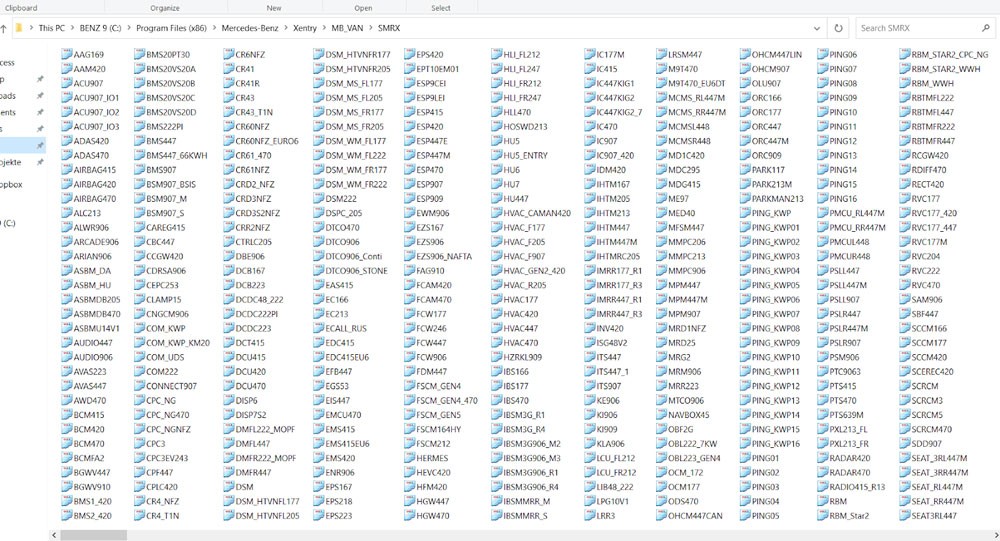 ECUs and SMR-d files in DTS Monaco
ECUs and SMR-d files in DTS Monaco
6. Step-by-Step Guide: Setting Up DTS Monaco with VXDIAG VCX SE Benz
To get started with DTS Monaco, you’ll need to set it up correctly with a compatible Vehicle Communication Interface (VCI). Here’s a step-by-step guide using VXDIAG VCX SE Benz:
6.1 Hardware and Software Requirements
Before you begin, ensure you have the necessary hardware and software:
- VXDIAG VCX SE Benz diagnostic tool
- DTS Monaco software (version 8 or later)
- A Windows-based laptop with sufficient processing power and storage
- Stable internet connection for software updates and downloads
6.2 Installing VX Manager
The VX Manager is essential for managing the connection between your computer and the VXDIAG VCX SE device.
- Download VX Manager: Visit the VXDIAG website and download the latest version of VX Manager.
- Install VX Manager: Run the downloaded installer and follow the on-screen instructions to install VX Manager on your laptop.
- Connect VXDIAG VCX SE: Connect the VXDIAG VCX SE device to your laptop via USB.
- Launch VX Manager: Open VX Manager and wait for it to detect the VXDIAG VCX SE device.
- Update Firmware and Licenses: In VX Manager, navigate to the “Device” tab and update the firmware. Then, go to the “License” tab and update the licenses.
6.3 Configuring DTS Monaco
Once VX Manager is set up, configure DTS Monaco to communicate with the VXDIAG VCX SE device.
- Launch DTS Monaco: Open DTS Monaco on your laptop.
- Create a New Project: In DTS Monaco, go to “Administrate and manage DTS projects” and create a new project. Select the “Modular optimized databases” option.
- Import SMR-d Files: Import the relevant SMR-d files from the X-ENTRY package. These files contain the necessary information for DTS Monaco to communicate with the vehicle’s ECUs.
- Create a New Workspace: Create a new workspace in DTS Monaco, selecting the project you just created and a relevant template.
- Check Interfaces: In DTS Monaco, go to “System settings” and check the “Interfaces” to ensure that the VXDIAG VCX SE device is listed and active.
6.4 Connecting to the Vehicle
With the software configured, you can now connect to the vehicle and start performing diagnostic and car coding tasks.
- Connect VXDIAG VCX SE to OBD2 Port: Plug the VXDIAG VCX SE device into the vehicle’s OBD2 port.
- Turn on Vehicle Ignition: Turn on the vehicle’s ignition without starting the engine.
- Reconnect in VX Manager: In VX Manager, press the “Reconnect” button to ensure that the device is connected to the vehicle.
- Launch DTS Monaco Workspace: Open your workspace in DTS Monaco and wait for the program to load.
6.5 Basic Troubleshooting
If you encounter issues during setup, here are some troubleshooting steps:
- Check USB Connection: Ensure that the USB connection between the VXDIAG VCX SE device and your laptop is stable.
- Update Drivers: Make sure that you have the latest drivers installed for the VXDIAG VCX SE device.
- Firewall Settings: Check your firewall settings to ensure that DTS Monaco and VX Manager are not being blocked.
- Restart Software: Try restarting DTS Monaco and VX Manager to resolve any temporary issues.
7. Advanced Techniques in DTS Monaco
Once you’re comfortable with the basics of DTS Monaco, you can explore advanced techniques to unlock its full potential.
7.1 Defeating Firewalls
Newer vehicles have firewalls that prevent unauthorized access to the ECUs. DTS Monaco includes methods to bypass these firewalls, allowing you to perform car coding and ECU flashing tasks.
- Identify Firewall ECU: Determine which ECU controls the firewall. For newer vehicles, it’s often EZS167.
- Open Firewall ECU in New Tab: In DTS Monaco, open the firewall ECU in a new tab.
- Security Access Level: Go to “Generic Jobs” and select the appropriate security access level (e.g., “Security Access Level 3B” for EZS167).
- Transmit: Press the “Transmit” button. If successful, you should see an “acknowledged” Response State with no red text.
7.2 Variant Coding
Variant coding allows you to customize vehicle settings and enable or disable features.
- Open Relevant ECU in New Tab: Open the ECU you want to code in a new tab (e.g., “HU6” for MBUX settings).
- Extended Start: Select “Extended Start” and press Transmit to prepare the ECU for coding.
- Variant Coding Tab: Go to the “Variant Coding” tab and select your ECU.
- Domain List: Navigate the “Domain” list to find the specific function you want to change.
- Modify Value: Double-click the value under “Meaning” and select the new value from the dropdown menu.
- Do Coding: Press the “Do Coding” button. The bar should go to 100% with the new value displayed.
7.3 Making Changes Permanent
To ensure that your car coding changes are permanent, you need to synchronize the changes to non-volatile memory and perform a hard reset.
- Synchronize to Non-volatile Memory Start: In the ECU tab, find and transmit “[31] Synchronize to Non-volatile Memory Start.”
- Synchronize to Non-volatile Memory Results: Next, transmit “[31] Synchronize to Non-volatile Memory Results.”
- Hard Reset: Perform a hard reset by turning off the vehicle, opening the driver’s door, and waiting a few minutes.
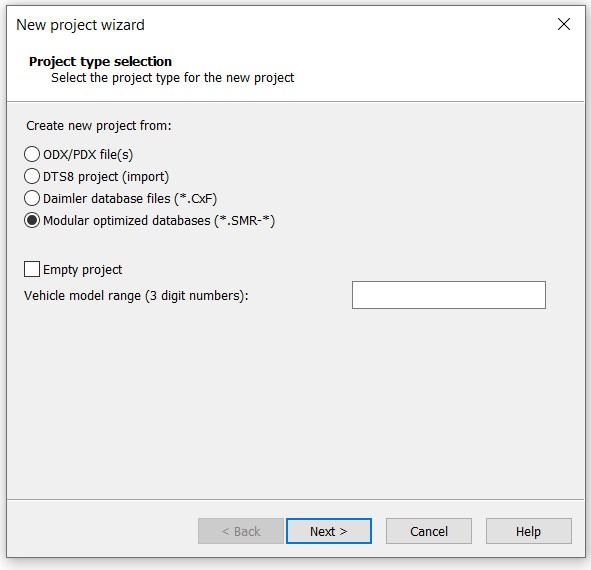 Sprinter VS30 coding with VXDIAG VCX SE DTS Monaco
Sprinter VS30 coding with VXDIAG VCX SE DTS Monaco
8. Addressing Common Challenges and Solutions
Working with DTS Monaco can present certain challenges. Here are some common issues and their solutions:
8.1 Connection Problems
Problem: DTS Monaco fails to connect to the vehicle or the VXDIAG VCX SE device.
Solution:
- Check USB Connection: Ensure the USB cable is securely connected to both the laptop and the VXDIAG VCX SE device.
- Update VX Manager: Verify that you have the latest version of VX Manager installed.
- Device Drivers: Confirm that the device drivers for the VXDIAG VCX SE are up to date.
- Firewall Settings: Ensure that firewall settings are not blocking the connection.
- Restart Devices: Restart both the laptop and the VXDIAG VCX SE device.
8.2 SMR-d File Issues
Problem: DTS Monaco cannot find or load the required SMR-d files.
Solution:
- Verify File Location: Ensure that the SMR-d files are in the correct directory and that DTS Monaco is pointed to this directory.
- Correct Files: Double-check that you have selected the correct SMR-d files for your vehicle model and ECU.
- File Integrity: Verify that the SMR-d files are not corrupted by re-copying them from the source.
8.3 Coding Errors
Problem: Variant coding fails or produces unexpected results.
Solution:
- Firewall Status: Confirm that the firewall has been successfully disabled before attempting to code.
- Extended Start: Ensure that you have performed the “Extended Start” procedure on the ECU.
- Correct Values: Double-check the values you are changing and ensure they are appropriate for your vehicle and desired outcome.
- Backup: Always create a backup of the original coding before making changes.
8.4 Software Compatibility
Problem: DTS Monaco is not compatible with your operating system or other software.
Solution:
- System Requirements: Verify that your laptop meets the minimum system requirements for DTS Monaco.
- Compatibility Mode: Try running DTS Monaco in compatibility mode for an older version of Windows.
- Software Conflicts: Identify and resolve any software conflicts that may be interfering with DTS Monaco.
9. The Future of DTS Monaco in Automotive Diagnostics
DTS Monaco is continuously evolving, with new features and capabilities being added to meet the changing needs of the automotive industry.
9.1 Integration with Cloud Services
Future versions of DTS Monaco are likely to integrate with cloud services, providing access to real-time diagnostic data, software updates, and remote support.
9.2 Enhanced Automation
Automation will play an increasingly important role in DTS Monaco, with new tools and features designed to streamline repetitive tasks and improve efficiency.
9.3 Artificial Intelligence
AI-powered diagnostic tools will help technicians identify issues more quickly and accurately, reducing diagnostic time and improving overall service quality.
9.4 Cybersecurity Enhancements
With the increasing connectivity of modern vehicles, cybersecurity is becoming a critical concern. Future versions of DTS Monaco will include enhanced security features to protect against unauthorized access and cyberattacks.
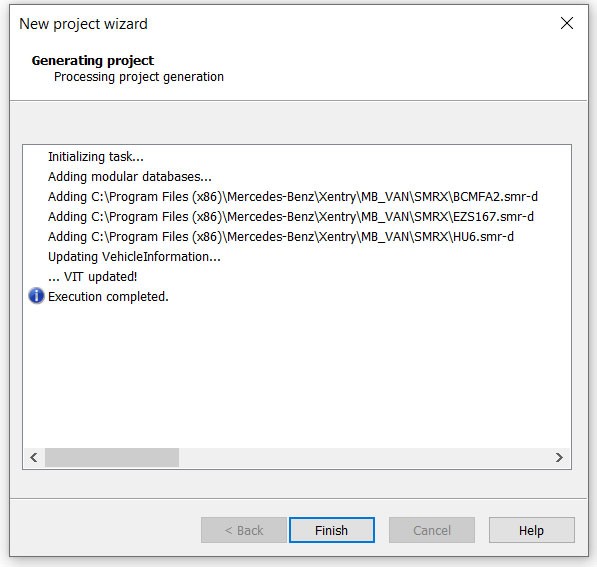 Sprinter VS30 coding with VXDIAG VCX SE DTS Monaco
Sprinter VS30 coding with VXDIAG VCX SE DTS Monaco
10. FAQs About DTS Monaco
Here are some frequently asked questions about DTS Monaco:
1. What is DTS Monaco?
DTS Monaco is a diagnostic, car coding, and ECU flashing software used in the automotive industry, particularly within the Daimler ecosystem.
2. What are the main purposes of DTS Monaco?
Its primary purposes include advanced diagnostics, ECU programming, variant coding, and performance tuning.
3. Is DTS Monaco user-friendly?
While it is a powerful tool, mastering DTS Monaco requires training and experience. DTS-MONACO.EDU.VN offers comprehensive courses to help users of all levels.
4. What hardware is compatible with DTS Monaco?
DTS Monaco is compatible with various Vehicle Communication Interfaces (VCIs), including VXDIAG VCX SE Benz.
5. How can I update DTS Monaco?
Software updates are typically provided by the software vendor. Check the official website or software interface for update notifications.
6. Can DTS Monaco be used for all car brands?
While primarily used within the Daimler ecosystem, DTS Monaco can be adapted for use with other car brands with the appropriate SMR-d files.
7. What are SMR-d files?
SMR-d files contain the necessary data for DTS Monaco to communicate with specific ECUs. They define the parameters and settings for each ECU.
8. Is it safe to perform car coding with DTS Monaco?
When performed correctly, car coding with DTS Monaco is safe. However, it is crucial to back up original settings and follow proper procedures to avoid damaging the vehicle’s systems.
9. How does DTS-MONACO.EDU.VN help in learning DTS Monaco?
DTS-MONACO.EDU.VN offers comprehensive training courses, hands-on practical exercises, expert support, and certification programs to help users master DTS Monaco.
10. Where can I get support for DTS Monaco?
Support is available through DTS-MONACO.EDU.VN, online forums, and the software vendor’s official channels.
Unlock the full potential of your automotive career with DTS Monaco! Visit DTS-MONACO.EDU.VN today to explore our comprehensive training courses and expert support. Whether you’re looking to enhance your diagnostic skills, streamline car coding processes, or master ECU flashing, we have the resources you need to succeed. Don’t miss out on the opportunity to become a certified DTS Monaco professional—contact us now to learn more and start your journey towards automotive excellence. Address: 275 N Harrison St, Chandler, AZ 85225, United States. Whatsapp: +1 (641) 206-8880.
